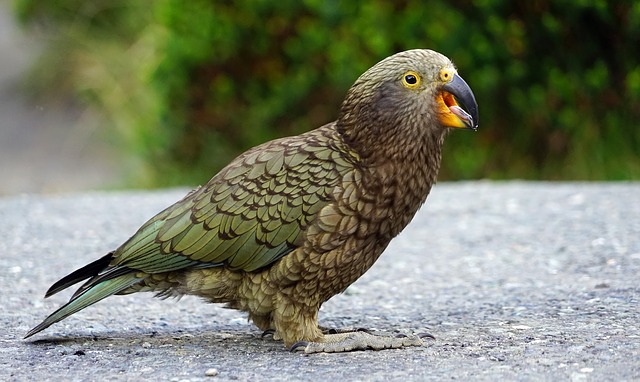Throughout history, birds have been symbols of our highest ideals. From songbirds to soaring eagles, they represent the beauty of nature, the devotion of parents, the freedom of the spirit… But are they so far removed from our dirty, mundane ways?
Here are 10 birds with a surprisingly terrifying dark side.
10. The Parasite Ranger
With its sharp wings and dark feathers, the parasitic jaeger (German for "hunter") resembles a angry seagull . It acts like one too. The parasitic part of its name refers to its habit of stealing food from other birds in the air.
By chasing them and snatching their prey, this bird is a "daring" pirate. In fact, like pirates, they spend much of their lives at sea - often over rough waters - "attacking other seabirds... attacking in groups until they give up their prey." He goes out to the shore just to have sex In Europe it is known as the Arctic skua because it breeds in the tundra in the north. But even then it is a threat, eating other birds and their eggs.
Besides, it sounds like a baby crying .
9. Pelican

With their duck feet, flamingo heads and symbolic association with selflessness Pelicans have a place in our hearts. Perhaps it is the pelican, and not a stork , gave birth to our children in folklore. They certainly have the beak for it.
In fact, you should never leave your child with a pelican or anything else you like for that matter. When stressed or hungry, it snaps at everyone and swallows other creatures indiscriminately. Victims pelicans became goslings, baby penguins, ducks , pigeons, baby turtles and chihuahua .
Once caught in the pelican's beak, the prey goes down into the throat while still alive. If the pelican is hungry, it will go into the stomach; if not, it will go to harvest. This is the pelican's food storage sac, where, in the absence of enzymes, mucus helps soften the prey .
8. Cassowary
Without this colorful flightless bird, some Australian plants wouldn't grow. Some seeds - too big for other frugivores to swallow - can only germinate after passing through the cassowary's digestive tract. So that's one thing in its favor.
But the cassowary is also the world's most dangerous bird. With a 4-inch dagger-like claw on each foot, it can "cut through any... potential threat with a single with a quick strike " Add to that a running speed of up to 30 miles per hour and a vertical leap of nearly seven feet, and it's eerily reminiscent of velociraptors. They even scare each other. Mostly solitary, cassowaries rarely show affection when they meet. Males quickly intimidate each other, and females can send them running with a single glance. When they communicate, however, it's with ultra-low-frequency thumps that we can feel in our bones.
Unsurprisingly, cassowaries have occasionally killed humans. They typically charge, kick, or jump on their victims, but may also peck or headbutt, causing “puncture wounds, lacerations, and broken bones.” It is not good to hide indoors; cassowaries have also been known to kick and peck doors and windows, sometimes breaking the glass. Interestingly, however, this is considered a preemptive strike. by their reflection Apparently, cassowaries are so scary that they are afraid even of themselves.
7. Whalehead
The prehistoric appearance of the shoebill has long fascinated people. Not only did it appear in ancient Egyptian art, but it continues to inspire today: the shoebill was the source inspiration for Princess Zelda's Loftwing or Guardian Bird V The Legend of Zelda: Skyward Sword .
Standing over a meter tall with an eight-foot wingspan, the shoebill is a fearsome hunter, preying on giant fish, snakes, baby crocodiles, and even Nile monitor lizards. Its most striking feature (literally) is its curved, sabot-like beak, which earned it the Arab nickname abu markhub (father of the shoe). Although it may appear to be smiling, that beak is a powerful weapon, clamping and decapitating the prey . For us it even sounds deadly - like a machine gun, when he greets other whaleheads.
However, this bird shows its dark side not as a hunter; it returns to the nest as a chick. In David Attenborough's film "Africa" There is heartbreaking footage : When a mother shoebill leaves her nest for water, the eldest of her chicks bullies the other one, viciously tugging and pecking at its down feathers. Already weak, the young chick struggles to support its own weight. And when the mother returns and sees what has happened, she pragmatically favors the bully, completely ignoring the victim. This may explain why Rarely does more than one shoebill chick survive .
6. Cuckoo
The cuckoo's call is the first sign of spring, but birds have good reason to fear it, even if they don't always know it. As brood parasites, cuckoos lay their eggs in other birds' nests for the host birds to raise as their own. This, of course, saves energy. Some even drop their eggs from the air into the nest - their thick shells are like bombs, shattering the hosts' eggs on impact.
But while it may seem casual, the cuckoo's approach is actually carefully planned. Nests are not chosen at random; cuckoos staked out their claim in advance. Hiding in the shadows, they watch the movements of their hosts to synchronize their egg-laying and the timing of their penetration. Then, while the females are prowling, the males (which in some species resemble hawks) may create a distraction, luring the host birds into a fight.
The cuckoo's parenting doesn't end there; they have been found to check on their young. In fact, the Great Spotted Cuckoo not only returns to check on its chicks, but also punishes birds that reject them, usually by killing their young. However this mafia "racket" not always needed. Although cuckoo chicks are not raised directly by their parents, they follow them: hatching earlier and stronger than their parasitized nestmates, they literally drive them out .
5. Reed Warbler

Europe's favourite songbirds, warblers are easy prey for cuckoos. Not only is the mother warbler unlikely to notice the impostors, but she will continue feeding even when they will become twice as big as it is . Moreover, she doesn't seem to notice when other eggs are pushed out of the nest. However, this doesn't mean that reed warblers are disinterested or naive; they have a clever parenting strategy of their own.
Because male reed warblers only ever provide one nest - even if they have produced many - females are "low harem rank" destroy eggs their rivals. Researchers observed this behavior by filling artificial nests with plasticine eggs and matching the markings to warblers. Essentially, when a mistress destroys her first wife's children, she moves up in the support queue.
Newly arrived females also try to profit from the killings. By building their nests near the site of the infanticide, they are more likely to capture the male.
4. Shrike

With its small stature, raccoon mask, and high-pitched squeaking call, the shrike is undeniably cute. But it’s also a bird of prey—and a psychopath. You may have seen insects, like beetles, impaled on a barbed-wire fence. It’s not an uncommon sight. In fact, it’s a sure sign that a shrike (or a psychopathic child) is nearby.
To attract partners , shrikes impale insects, amphibians, lizards, small mammals, and even birds on fences or thorny trees and cacti. This is also a way to store food, especially when it is poisonous, allowing time for the toxins to be excreted. Unlike other birds of prey, shrikes do not have talons. So they rely on their small, hooked beaks to impale their prey on thorns. In other words, the prey can remain alive for some time in "pantry" of the shrike or, as it is called, in the shrike's "pantry", even if it is slowly being taken apart.
Speaking of psychopathic children, shrikes learn this trick quite early. Young individuals practice with leaves , placing them on branches near their nest.
3. Kea

This stunningly beautiful mountain parrot is a national treasure of New Zealand and is featured on banknotes , V novels And old Maori myths In Scouts New Zealand, "kea" is also called 5-8 year old participant It is also a national pest.
Standing on the backs of sheep, the kea eats them alive, ripping out their loins with its beak. One farmer in 2009 claimed to have lost up to 30 sheep in two months to "kea strikes". In one horrific case, he discovered that "the entire intestinal cavity is open."
It's a conundrum for New Zealanders. On the one hand, the bird is protected under the highest category of wildlife protection. On the other, the lamb is a major export commodity. The government's current solution is to issue permits to shoot keas on a case-by-case basis, but they must be "caught in the act".
2. Black vulture

Gathering like witches, abandoned buildings , black vultures stalk turkey vultures to steal their food, hissing at them to scare them away. However, their real calling lies elsewhere. The species is notorious among Kentucky farmers for preying on livestock and pets. Apparently, "they like to play with newborn babies… they will jump around and make the calf comfortable… before they peck it out eyes " - "Then the tongue, then every last shred of flesh." It's all over in a few minutes.
They are also known to attack pregnant sheep, right during birth, surgically ripping off the mother's skin to feast on her meat and lamb.
As with the kea, there's little farmers can do. The Migratory Bird Treaty Act prohibits harming them without a federal permit. Sure, like any species, they have their merits (they're great for roadkill), but it's hard not to see them as evil.
1. Duck

Who doesn't like ducks, with their innocent quacking and often colorful plumage? We'll tell you: people who know their dark secret.
Male ducks (drakes) are among the three percent of birds with a penis, and of these, they are the best endowed. In fact, relative to body size, they are the best endowed of all vertebrates. The Argentine lake duck, for example, is four inches longer than its body. Even more unique, duck penises are corkscrew-curled — like pig tails, with up to ten coils. And, “like a selection of sex toys from a vending machine in a weird alien bar,” they come ribbed, ridged, and even scalloped.
You might say there's nothing wrong with that, except that it was all done "for her pleasure." In fact, to stop her escape . Because most duck species have more males than females, many drakes simply cannot attract a mate. So instead, they resort to violent, often fatal gang rapes. This behavior is so ingrained in ducks that the penis has evolved to hook onto the vagina. And, like a “sexual arms race,” the vagina has evolved its own defenses. For example, it may spiral in the opposite direction to the penis, or have “dead-end side pockets or dead-end sacs” to trap unwanted sperm. Recalling dentate vagina from folklore, some also have sharp turns or "teeth".














Оставить Комментарий